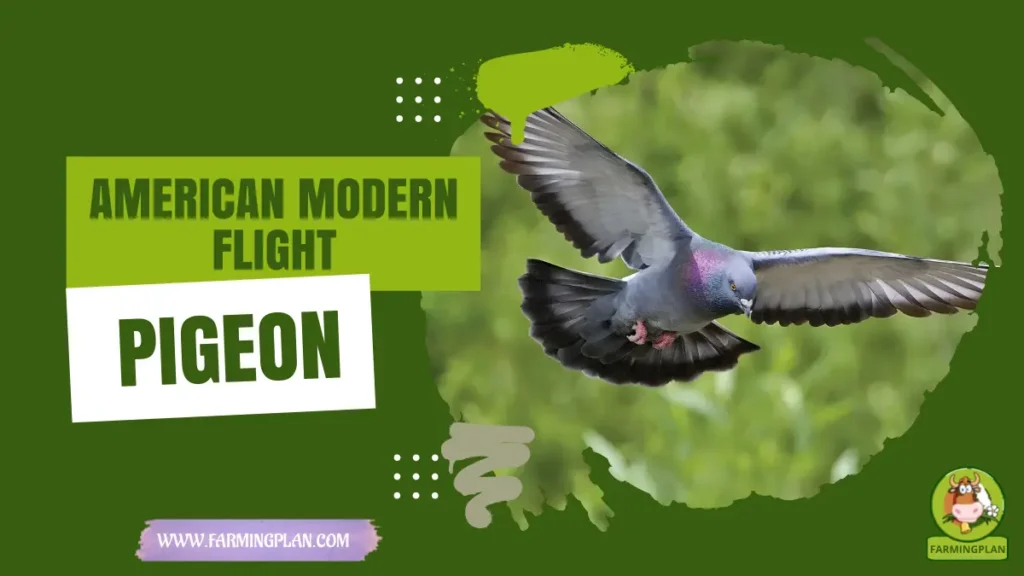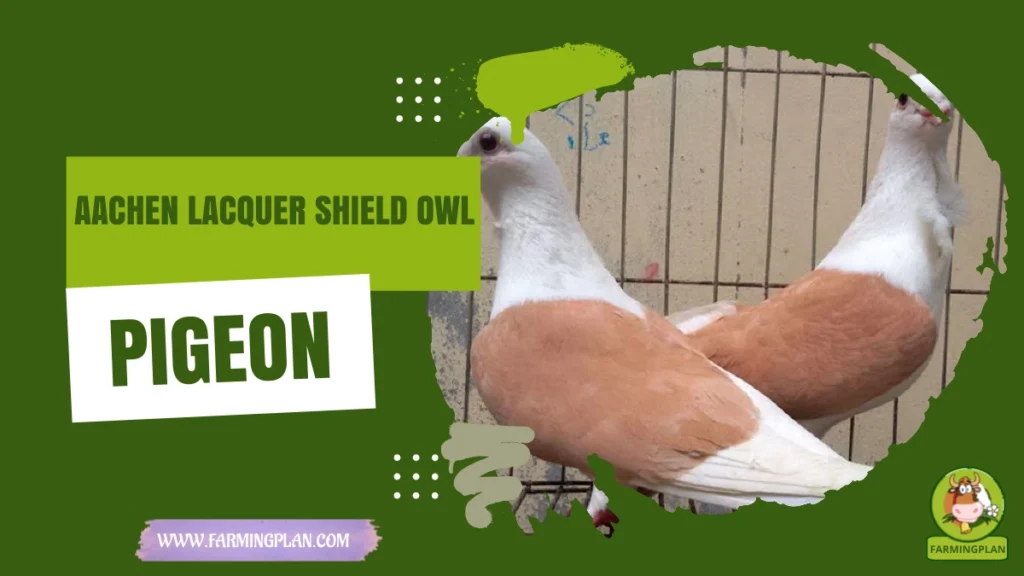When I first laid eyes on the American Modern Flight Pigeon, I knew I was looking at something truly special. This pigeon isn’t just about looks—it’s got brains, beauty, and breathtaking flight skills. Raised mostly in New York and beloved across the United States, this pigeon breed is known for its acrobatics, charm, and proud appearance. Whether you’re a breeder, pet owner, or hobbyist, you’ll quickly fall in love with how this bird takes the skies—and hearts—by storm. So, if you’ve ever wondered what makes the American Modern Flight Pigeon such a favorite in the pigeon world, you’re in the right place. Let’s dive into the world of feathers, flight, and finesse!

History & Origin of American Modern Flight Pigeon
The American Modern Flight Pigeon, often affectionately called the AMF Pigeon, is a breed with unique characteristics that set it apart. With its roots deeply planted in the urban skylines of New York City, this breed was developed through selective breeding from various flying and tumbling breeds like Tumblers, Rollers, and Homing Pigeons. The goal was to create a stylish, agile, and high-flying bird with excellent control and grace in the air.
Many pigeon enthusiasts in the early to mid-20th century started breeding these birds not just for flight but for form. They wanted a pigeon that looked sharp, flew high, and could perform aerial acrobatics while maintaining a distinctive body style. Over the decades, the breed was refined with influence from Asiatic Crack Tumblers, Lacquer Shield Owls, and other fancy pigeon types.
Today, the AMF Pigeon stands tall among the finest domestic fancy pigeon breeds, recognized for both performance and beauty. It’s a symbol of both urban pigeon sport culture and selective avian craftsmanship. But what truly sets it apart are its unique characteristics and specific health needs. Understanding these aspects is crucial for providing the best care for your pigeons.
Read More: English Longhorn Cattle – A Rare Farm Treasure
Characteristics of American Modern Flight Pigeon
The American Modern Flight Pigeon is a true showstopper. These birds are medium-sized with a strong, upright stance that gives them a proud, almost royal posture. They come in a variety of colors—from crisp whites and rich blacks to speckled blues and metallic tints. Some even carry the classic “shield” pattern on their wings, like you’d see in color pigeons or Archangel pigeons.
What truly sets the AMF Pigeon apart are its wing shape and tail posture. The wings are long and pointed, ideal for slicing through the sky during flight. Their tail feathers are fanned and neat, adding elegance to every take-off. Their eyes? Bright, alert, and full of curiosity. Another fun trait is their intense homing instincts. Like their cousins, the carrier pigeons, they remember loft locations well and return with precision. Their build is sleek and aerodynamic but still strong enough to handle rough weather conditions or long flights.
Nature & Temperament of American Modern Flight Pigeon
If I had to sum up the AMF Pigeon’s personality, it’s part athlete, part showman, and 100% loyal companion. These birds are energetic, highly alert, and have a strong desire to fly. I’ve often seen them dart through the sky with wild joy and incredible control—it’s almost like they’re dancing on the wind. When handled from a young age, they can become quite friendly and calm.
They are social and easy-going around other birds, which makes them a great choice for community lofts. That said, they can be a little territorial during breeding season—nothing too dramatic, just a bit of puffed-chest attitude. These pigeons are smart, too. You can train them to respond to calls, return to the loft on cue, and even compete in pigeon racing or aerial display competitions. They’re not loud or overly demanding—just active and curious, which makes them perfect for both new and experienced pigeon fanciers.
Food & Diet of American Modern Flight Pigeon
Feeding the American Modern Flight Pigeon is all about balance. These birds burn a lot of energy during flight, so they need a high-protein, grain-based diet. I usually feed mine a mix of pigeon feed made up of corn, wheat, peas, millet, and safflower. For extra muscle-building, I add some lentils and oilseeds a few times a week. They love grit, which helps with digestion.
Make sure you offer them calcium-rich supplements, oyster shells, or crushed eggshells for strong bones and eggshell formation. Clean water is a must—change it daily to avoid bacterial buildup. Don’ts? Avoid processed human food, bread, or sugary treats. Those mess up their metabolism and lead to illness. Keep their food storage clean, dry, and rodent-free. A healthy diet equals a happy flier!
Usage & Purpose of American Modern Flight Pigeon
These pigeons do it all. While they’re often bred for flying competitions, many fanciers raise them for pigeon shows or fancy exhibitions due to their sharp looks. Their high-flying performance is admired in urban skyline flights, where flocks are released and watched as they spin, dive, and soar with dramatic flair. Some breeders use them for crossbreeding to pass on agility and structure to other breeds like the American Domestic Show Flight Pigeon or European Modern Flights.
Because of their intelligence and memory, they’re also great for light-duty messenger pigeon training. If you’re not into flying sports, they still make wonderful companion birds for your loft. They don’t require as much space as larger breeds and keep your skies lively. In some places, they’re even part of historic re-creations of war pigeon use, echoing the days of the Army Pigeon Service.
Special Features of American Modern Flight Pigeon
Whether you’re flying them for fun or showcasing them at events, they never fail to impress. They’re not just another bird—they’re sky artists. Here’s what really sets the American Modern Flight Pigeon apart:
- Stylish Flight Pattern – They soar high, then tumble, twist, and glide back with flair.
- Loyal Homing Ability – Even after hours in the sky, they find their way home.
- Adaptability – These pigeons do well in both warm and cold climates.
- Unique Colors & Markings – From glossy black to bright white, and even albino pigeons, the color range is huge.
- Performance Lineage – Bred from top tumblers and flyers, they have real pedigree.
Health Issues & Prevention of American Modern Flight Pigeon
Like any breed, the AMF Pigeon can face health challenges. Pigeon Paramyxovirus (PMV) is a big concern—it affects coordination and balance. Keep your flock vaccinated yearly. Other risks include canker, coccidiosis, lice, and respiratory infections. I make sure to check each bird weekly. Look at droppings, eyes, breathing, and weight.
A drop in energy, ruffled feathers, or unusual poop is a red flag. Clean lofts, fresh air, and dust-free bedding help keep diseases away. I always say: prevention beats treatment. Give your birds clean water, good food, natural sunlight, and space to fly. Add garlic or apple cider vinegar to their water once a week to boost immunity. If things go south, don’t hesitate—call your avian vet.
Read More: Australian Spotted Duck – A Charming Backyard Treasure
“Every Pigeon Has A Story—But The American Modern Flight Tells It In The Sky.”
Step-by-Step Pet Owner Care Guide of American Modern Flight Pigeon
Caring for American Modern Flight Pigeons is rewarding, but it takes planning, consistency, and a whole lot of love. Here’s how I raise mine from fledglings to flying champs:
Step 1: Build the Perfect Loft
Your first job is to give them a solid home. I recommend a raised, ventilated, and predator-proof loft. Use wire mesh for airflow and windows for natural light. Size? For 10 pigeons, go with at least 6×8 feet and keep it super clean. Add perches, nesting boxes, and secure doors. Include a landing board for easy return from flights. Floor should have wire mesh or dry bedding (avoid hay—it molds). Deep-clean monthly and remove droppings daily.
Step 2: Train for Loft Loyalty
Start with young birds. Keep them inside for 2–3 weeks before the first flight. Hand-feed occasionally and use a call sound or whistle during feeding—this builds trust and response. When you finally let them fly, do it early morning with no food in the loft. They’ll explore but return hungry. After a few sessions, they learn the pattern. Never fly them too far early on—slow and steady wins.
Step 3: Daily Care Routine
Each day, feed twice—morning and afternoon. Refresh their water, check their bodies and behavior, and clean droppings from under perches. Watch for signs of illness. Rotate in training flights every other day. On off days, allow rest or sunbathing time. Add grit trays, dust baths, and even hanging toys for stimulation.
Step 4: Breeding Basics of American Modern Flight Pigeon
Want babies? Pair them up in a quiet corner with a nesting bowl, soft straw, and privacy. Most lay two eggs. Incubation takes 18 days, and the parents handle it well. Pigeon milk, produced in the crop, feeds the babies the first week. Once the young fledge, separate by gender for tracking. Keep breeder logs and health notes. Responsible breeding avoids inbreeding and keeps lines strong.
Expert Tips & Best Practices of American Modern Flight Pigeon
- Fly in the morning – Cool, calm weather helps focus and flight control.
- Use colored leg bands – Helps identify, track lineage, and avoid mix-ups.
- Mix vinegar in water once a week – Boosts gut health and deters parasites.
- Introduce new birds slowly – Quarantine for two weeks before mixing flocks.
- Keep loft dry – Wet conditions invite bacteria and mold.
- Talk to your birds – Yes, really! They learn your voice and calm down faster.
FAQs
What is an American Modern Flight Pigeon used for?
They’re mainly used for high-flying displays, show competitions, and breeding programs thanks to their athleticism and beauty.
How high can AMF pigeons fly?
They can reach several hundred feet in the air, often flying in tight patterns or circles during aerial displays.
Are American Modern Flight Pigeons good for beginners?
Yes! With proper care and training, they’re great for new pigeon fanciers and are easy to manage.
How long do AMF pigeons live?
With good care, they typically live 10–15 years.
What’s the difference between AMF and roller pigeons?
AMFs are bred for sustained high flying and visual display, while roller pigeons tumble and spin more frequently during flight.
Conclusion
Raising American Modern Flight Pigeons has been one of the most rewarding parts of my journey as a bird keeper. From their bold beauty to their incredible aerial stunts, these birds are born to impress. They’re loyal, smart, and surprisingly easy to care for once you get the hang of it. Whether you’re a seasoned fancier or just curious about pigeon breeds, the AMF pigeon brings both joy and excitement to your backyard loft. Got questions or cool flight stories? I’d love to hear them! Share this guide, drop a comment, or connect with fellow pigeon lovers. Let’s keep this amazing breed flying high—together!


